Fluorinated Polyimide/Allomelanin Nanocomposites for UV-Shielding Applications
Abstract
:1. Introduction
2. Results and Discussion
2.1. Preparation and Characterization of AMNPs
2.2. Analysis of FPI/AMNPs Films
2.3. Structure Analysis
2.4. Mechanical Properties
2.5. Optical Properties
2.6. UV-Shielding Performance
3. Experimental Section
3.1. Materials
3.2. Preparation of AMNPs
3.3. Preparation of FPI/AMNPs Films
3.4. UV-Shielding Measurement
3.5. Characterization
4. Conclusions
Author Contributions
Funding
Institutional Review Board Statement
Informed Consent Statement
Data Availability Statement
Conflicts of Interest
Sample Availability
References
- El-Hosainy, H.; Mine, S.; Toyao, T.; Shimizu, K.-I.; Tsunoji, N.; Esmat, M.; Doustkhah, E.; El-Kemary, M.; Ide, Y. Layered silicate stabilises diiron to mimic UV-shielding TiO2 nanoparticle. Mater. Today Nano 2022, 19, 100227. [Google Scholar] [CrossRef]
- Wirunchit, S.; Apivitcholchat, C.; Chodjarusawad, T.; Koetniyom, W. The study of UV protection materials. In Proceedings of the AIP Conference Proceedings, Casablanca, Morocco, 2–5 October 2018. [Google Scholar]
- Wang, X.; Li, X.; Yang, X.; Lei, K.; Wang, L. The innovative fabrication of nano-natural antimicrobial agent@polymeric microgels-TiO(2) hybrid films capable of absorbing UV and antibacterial on touch screen panel. Colloids Surf. B Biointerfaces 2021, 197, 111410. [Google Scholar] [CrossRef]
- Li, P.; Guo, W.; Lu, Z.; Tian, J.; Li, X.; Wang, H. UV-responsive single-microcapsule self-healing material with enhanced UV-shielding SiO2/ZnO hybrid shell for potential application in space coatings. Prog. Org. Coat. 2021, 151, 106046. [Google Scholar] [CrossRef]
- Yang, D.; Ramu, A.G.; Choi, D. Synthesis of Transparent ZnO–TiO2 and Its Nanocomposites for Ultraviolet Protection of a Polyethylene Terephthalate (PET) Film. Catalysts 2022, 12, 1590. [Google Scholar] [CrossRef]
- Han, C.; Wang, F.; Gao, C.; Liu, P.; Ding, Y.; Zhang, S.; Yang, M. Transparent epoxy–ZnO/CdS nanocomposites with tunable UV and blue light-shielding capabilities. J. Mater. Chem. C Mater. 2015, 3, 5065–5072. [Google Scholar] [CrossRef]
- Silva, M.R.F.; Alves, M.F.R.P.; Cunha, J.P.G.Q.; Costa, J.L.; Silva, C.A.; Fernandes, M.H.V.; Vilarinho, P.M.; Ferreira, P. Nanostructured transparent solutions for UV-shielding: Recent developments and future challenges. Mater. Today Phys. 2023, 35, 101131. [Google Scholar] [CrossRef]
- Li, Q.; Guo, Y.; Ouyang, C.; Yi, S.; Liu, S. Porous highly fluorinated polyimide/polydopamine nanocomposite films with simultaneously enhanced toughness, UV-shielding and photostability for aerospace applications. Polym. Test 2023, 118, 107899. [Google Scholar] [CrossRef]
- Li, Q.; Guo, Y.; Yi, S.; Xu, Z.; Duan, W.; Liu, S. Fluorinated Polyimide/Sepia Eumelanin Nanocomposites for Aerospace Applications. ACS Appl. Polym. Mater. 2023, 5, 1520–1529. [Google Scholar] [CrossRef]
- Sun, H.; Xi, Y.; Tao, Y.; Zhang, J. Facile fabrication of multifunctional transparent glass with superhydrophobic, self-cleaning and ultraviolet-shielding properties via polymer coatings. Prog. Org. Coat. 2021, 158, 106360. [Google Scholar] [CrossRef]
- Qiao, R.M.; Zhao, C.P.; Liu, J.L.; Zhang, M.L.; He, W.Q. Synthesis of Novel Ultraviolet Absorbers and Preparation and Field Application of Anti-Ultraviolet Aging PBAT/UVA Films. Polymers 2022, 14, 1434. [Google Scholar] [CrossRef]
- Li, A.; Liu, Y.; Wang, Z.; Song, Z.; Zhang, Y.; Wang, Y.; Xu, B.; Qi, F.; Ikhlaq, A.; Kumirska, J.; et al. Catalytic ozonation membrane reactor integrated with CuMn2O4/rGO for degradation emerging UV absorbers (BP-4) and fouling in-situ self-cleaning. Sep. Purif. Technol. 2021, 279, 119804. [Google Scholar] [CrossRef]
- Babaahmadi, V.; Abuzade, R.A.; Montazer, M. Enhanced ultraviolet-protective textiles based on reduced graphene oxide-silver nanocomposites on polyethylene terephthalate using ultrasonic-assisted in-situ thermal synthesis. J. Appl. Polym. Sci. 2022, 139, 52196. [Google Scholar] [CrossRef]
- He, W.; Lu, L. Revisiting the Structure of Graphene Oxide for Preparing New-Style Graphene-Based Ultraviolet Absorbers. Adv. Funct. Mater. 2012, 22, 2542–2549. [Google Scholar] [CrossRef]
- Xie, S.; Zhao, J.; Zhang, B.; Wang, Z.; Ma, H.; Yu, C.; Yu, M.; Li, L.; Li, J. Graphene Oxide Transparent Hybrid Film and Its Ultraviolet Shielding Property. ACS Appl. Mater. Interfaces 2015, 7, 17558–17564. [Google Scholar] [CrossRef] [PubMed]
- Ahmed, A.; Adak, B.; Bansala, T.; Mukhopadhyay, S. Green Solvent Processed Cellulose/Graphene Oxide Nanocomposite Films with Superior Mechanical, Thermal, and Ultraviolet Shielding Properties. ACS Appl. Mater. Interfaces 2020, 12, 1687–1697. [Google Scholar] [CrossRef]
- Cai, H.; Shen, D.; Yuan, L.; Guan, Q.; Gu, A.; Liang, G. Developing thermally resistant polydopamine@nano turbostratic BN@CeO2 double core-shell ultraviolet absorber with low light-catalysis activity and its grafted high performance aramid fibers. Appl. Surf. Sci. 2018, 452, 389–399. [Google Scholar] [CrossRef]
- Hao, L.; Gong, L.; Chen, L.; Guan, M.; Zhou, H.; Qiu, S.; Wen, H.; Chen, H.; Zhou, X.; Akbulut, M. Composite pesticide nanocarriers involving functionalized boron nitride nanoplatelets for pH-responsive release and enhanced UV stability. Chem. Eng. J. 2020, 396, 125233. [Google Scholar] [CrossRef]
- Rasul, M.G.; Kiziltas, A.; Arfaei, B.; Shahbazian-Yassar, R. 2D boron nitride nanosheets for polymer composite materials. NPJ 2D Mater. Appl. 2021, 5, 56. [Google Scholar] [CrossRef]
- Yuan, B.; Ji, X.; Nguyen, T.T.; Huang, Z.; Guo, M. UV protection of wood surfaces by graphitic carbon nitride nanosheets. Appl. Surf. Sci. 2019, 467, 1070–1075. [Google Scholar] [CrossRef]
- Yuan, B.; Guo, M.; Huang, Z.; Naik, N.; Hu, Q.; Guo, Z. A UV-shielding and hydrophobic graphitic carbon nitride nanosheets/cellulose nanofibril (gCNNS/CNF) transparent coating on wood surface for weathering resistance. Prog. Org. Coat. 2021, 159, 106440. [Google Scholar] [CrossRef]
- Li, T.X.; Su, H.B.; Gao, L.; Jiang, L.; Zhang, C.X.; Han, Y.Q.; Wang, Y.M.; Wang, Q. Performance and Characterization of Resistance to Ultraviolet Radiation of Vi-POSS-TiO2/EP Nanocomposites. Mater. Sci. Forum 2016, 852, 411–416. [Google Scholar] [CrossRef]
- Revathi, R.K.; Hariharan, A.; Prabunathan, P.; Srinivasan, K.; Alagar, M. Multifunctional behavior of POSS-reinforced imidazole core polyimide nanocomposites. Polym. Bull. 2018, 76, 5059–5075. [Google Scholar] [CrossRef]
- Hu, B.; Li, L.; Guan, D.; Yang, B.; Li, G.; Wang, Z.; Han, R. Enhanced UV-shielding performance of poly(lactic acid) composite with POSS-modified bamboo powder. Ind. Crops Prod. 2023, 192, 116133. [Google Scholar] [CrossRef]
- Piness, J.; Knauer, K.; Wiggins, J. Novel POSS-Cerium Oxide Thermoset Nanocomposites For UV Degradation Mitigation. AIAA Space Conf. Expo. 2015, 4639. [Google Scholar] [CrossRef]
- Zhang, Y.; Naebe, M. Lignin: A Review on Structure, Properties, and Applications as a Light-Colored UV Absorber. ACS Sustain. Chem. Eng. 2021, 9, 1427–1442. [Google Scholar] [CrossRef]
- Piccinino, D.; Capecchi, E.; Tomaino, E.; Gabellone, S.; Gigli, V.; Avitabile, D.; Saladino, R. Nano-Structured Lignin as Green Antioxidant and UV Shielding Ingredient for Sunscreen Applications. Antioxidants 2021, 10, 274. [Google Scholar] [CrossRef]
- Sadeghifar, H.; Ragauskas, A. Lignin as a UV Light Blocker-A Review. Polymers 2020, 12, 1134. [Google Scholar] [CrossRef]
- Li, Q.; Liao, G.; Tian, J.; Xu, Z. Preparation of Novel Fluorinated Copolyimide/Amine-Functionalized Sepia Eumelanin Nanocomposites with Enhanced Mechanical, Thermal, and UV-Shielding Properties. Macromol. Mater. Eng. 2018, 303, 1700407. [Google Scholar] [CrossRef]
- d’Ischia, M.; Napolitano, A.; Pezzella, A.; Meredith, P.; Buehler, M. Melanin Biopolymers: Tailoring Chemical Complexity for Materials Design. Angew. Chem. Int. Ed. Engl. 2020, 59, 11196–11205. [Google Scholar] [CrossRef]
- Singh, S.; Nimse, S.B.; Mathew, D.E.; Dhimmar, A.; Sahastrabudhe, H.; Gajjar, A.; Ghadge, V.A.; Kumar, P.; Shinde, P.B. Microbial melanin: Recent advances in biosynthesis, extraction, characterization, and applications. Biotechnol. Adv. 2021, 53, 107773. [Google Scholar] [CrossRef]
- Zhou, X.; McCallum, N.C.; Hu, Z.; Cao, W.; Gnanasekaran, K.; Feng, Y.; Stoddart, J.F.; Wang, Z.; Gianneschi, N.C. Artificial Allomelanin Nanoparticles. ACS Nano 2019, 13, 10980–10990. [Google Scholar] [CrossRef] [PubMed]
- McCallum, N.C.; Son, F.A.; Clemons, T.D.; Weigand, S.J.; Gnanasekaran, K.; Battistella, C.; Barnes, B.E.; Abeyratne-Perera, H.; Siwicka, Z.E.; Forman, C.J.; et al. Allomelanin: A Biopolymer of Intrinsic Microporosity. J. Am. Chem. Soc. 2021, 143, 4005–4016. [Google Scholar] [CrossRef] [PubMed]
- Cao, W.; McCallum, N.C.; Ni, Q.Z.; Li, W.; Boyce, H.; Mao, H.; Zhou, X.; Sun, H.; Thompson, M.P.; Battistella, C.; et al. Selenomelanin: An Abiotic Selenium Analogue of Pheomelanin. J. Am. Chem. Soc. 2020, 142, 12802–12810. [Google Scholar] [CrossRef]
- Dadachova, E.; Bryan, R.A.; Howell, R.C.; Schweitzer, A.D.; Aisen, P.; Nosanchuk, J.D.; Casadevall, A. The radioprotective properties of fungal melanin are a function of its chemical composition, stable radical presence and spatial arrangement. Pigment Cell Melanoma Res. 2008, 21, 192–199. [Google Scholar] [CrossRef]
- Lino, V.; Manini, P. Dihydroxynaphthalene-Based Allomelanins: A Source of Inspiration for Innovative Technological Materials. ACS Omega 2022, 7, 15308–15314. [Google Scholar] [CrossRef]
- Ghaffari-Mosanenzadeh, S.; Aghababaei Tafreshi, O.; Karamikamkar, S.; Saadatnia, Z.; Rad, E.; Meysami, M.; Naguib, H.E. Recent advances in tailoring and improving the properties of polyimide aerogels and their application. Adv. Colloid Interface Sci. 2022, 304, 102646. [Google Scholar] [CrossRef]
- Zheng, W.; Yang, T.; Qu, L.; Liang, X.; Liu, C.; Qian, C.; Zhu, T.; Zhou, Z.; Liu, C.; Liu, S.; et al. Temperature resistant amorphous polyimides with high intrinsic permittivity for electronic applications. Chem. Eng. J. 2022, 436, 135060. [Google Scholar] [CrossRef]
- Wu, Z.; He, J.; Yang, H.; Yang, S. Progress in Aromatic Polyimide Films for Electronic Applications. Polymers 2022, 14, 1269. [Google Scholar] [CrossRef] [PubMed]
- Ma, S.; Wang, C.; Cong, B.; Zhou, H.; Zhao, X.; Chen, C.; Wang, D.; Liu, C.; Qu, C. Anisotropic all-aromatic polyimide aerogels with robust and high-temperature stable properties for flexible thermal protection. Chem. Eng. J. 2022, 431, 134047. [Google Scholar] [CrossRef]
- Li, Y.; Sun, G.; Zhou, Y.; Liu, G.; Wang, J.; Han, S. Progress in low dielectric polyimide film—A review. Prog. Org. Coat. 2022, 172, 107103. [Google Scholar] [CrossRef]
- Pan, X.F.; Wu, B.; Gao, H.L.; Chen, S.M.; Zhu, Y.; Zhou, L.; Wu, H.; Yu, S.H. Double-Layer Nacre-Inspired Polyimide-Mica Nanocomposite Films with Excellent Mechanical Stability for LEO Environmental Conditions. Adv. Mater. 2022, 34, 2105299. [Google Scholar] [CrossRef] [PubMed]
- Xu, Z.; Croft, Z.L.; Guo, D.; Cao, K.; Liu, G. Recent development of polyimides: Synthesis, processing, and application in gas separation. J. Polym. Sci. 2021, 59, 943–962. [Google Scholar] [CrossRef]
- An, L.; Yang, Z.; Zeng, X.; Hu, W.; Yu, Y.; Zhang, J.; Wang, Q. Flexible and quasi-isotropically thermoconductive polyimide films by guided assembly of boron nitride nanoplate/boron nitride flakes for microelectronic application. Chem. Eng. J. 2022, 431, 133740. [Google Scholar] [CrossRef]
- Zhang, Z.; Ren, X.; Huo, G.; Kang, S.; Wang, Z.; Li, N. Tuning interchain cavity of fluorinated polyimide by DABA for improved gas separation performance. J. Memb. Sci. 2023, 675, 121485. [Google Scholar] [CrossRef]
- Huang, H.; Wu, C.; Wu, S.; Pan, R.; Yin, L.; Jin, X.; Pan, Y.; Wang, H.; Yan, X.; Hong, C.; et al. Super-flexible, thermostable and superhydrophobic polyimide/silicone interpenetrating aerogels for conformal thermal insulating and strain sensing applications. Chem. Eng. J. 2022, 441, 136032. [Google Scholar] [CrossRef]
- Xu, W.; Long, J.; Liu, J.; Luo, H.; Duan, H.; Zhang, Y.; Li, J.; Qi, X.; Chu, L. A novel porous polyimide membrane with ultrahigh chemical stability for application in vanadium redox flow battery. Chem. Eng. J. 2022, 428, 131203. [Google Scholar] [CrossRef]
- Cheng, T.; Lv, G.; Li, Y.; Yun, H.; Zhang, L.; Deng, Y.; Lin, L.; Luo, X.; Nan, J. Low Dielectric Polyimide/Fluorinated Ethylene Propylene (PI/FEP) Nanocomposite Film for High-Frequency Flexible Circuit Board Application. Macromol. Mater. Eng. 2021, 306, 2100086. [Google Scholar] [CrossRef]
- Cao, G.; Chen, X.; Deng, B.; Wang, S.; Zhang, Q. Color construction of polyimide fibers based on charge transfer complex regulation and swelling effect. Appl. Surf. Sci. 2022, 597, 153593. [Google Scholar] [CrossRef]
- Zuo, H.; Chen, Y.; Qian, G.; Yao, F.; Li, H.; Dong, J.; Zhao, X.; Zhang, Q. Effect of simultaneously introduced bulky pendent group and amide unit on optical transparency and dimensional stability of polyimide film. Eur. Polym. J. 2022, 173, 111317. [Google Scholar] [CrossRef]
- Li, Q.; Liu, S.; Guo, Y.; Liang, Y.; Peng, H.; Chen, R.; Lei, F.; Wu, W.; Zhao, H.; Zhang, Q.; et al. Mussel-Inspired Polydopamine-Enhanced Polyimide for Ultrahigh Toughness and Ultraviolet Shielding Applications. ACS Appl. Polym. Mater. 2021, 3, 896–907. [Google Scholar] [CrossRef]
- Liu, Y.Y.; Wang, Y.K.; Wu, D.Y. Synthetic strategies for highly transparent and colorless polyimide film. J. Appl. Polym. Sci. 2022, 139, e52604. [Google Scholar] [CrossRef]
- Yi, C.; Li, W.; Shi, S.; He, K.; Ma, P.; Chen, M.; Yang, C. High-temperature-resistant and colorless polyimide: Preparations, properties, and applications. Sol. Energy 2020, 195, 340–354. [Google Scholar] [CrossRef]
- Tapaswi, P.K.; Ha, C.-S. Recent Trends on Transparent Colorless Polyimides with Balanced Thermal and Optical Properties: Design and Synthesis. Macromol. Chem. Phys. 2019, 220, 1800313. [Google Scholar] [CrossRef]
- Bisht, N.; Verma, A.; Chauhan, S.; Singh, V.K. Effect of functionalized silicon carbide nano-particles as additive in cross-linked PVA based composites for vibration damping application. J. Vinyl Addit. Technol. 2021, 27, 920–932. [Google Scholar] [CrossRef]
- Altobelli, R.; Salzano de Luna, M.; Filippone, G. Interfacial crowding of nanoplatelets in co-continuous polymer blends: Assembly, elasticity and structure of the interfacial nanoparticle network. Soft Matter 2017, 13, 6465–6473. [Google Scholar] [CrossRef]
- İnal, O.; Katnam, K.B.; Potluri, P.; Soutis, C. Progress in interlaminar toughening of aerospace polymer composites using particles and non-woven veils. Aeronaut. J. 2021, 126, 222–248. [Google Scholar] [CrossRef]
- Fu, Y.S.; Chen, T.H.; Weng, L.; Huang, L.; Lai, D.; Weng, C.F. Pharmacological properties and underlying mechanisms of curcumin and prospects in medicinal potential. Biomed. Pharmacother. 2021, 141, 111888. [Google Scholar] [CrossRef] [PubMed]
- Xu, Y.; Liu, X.; Jiang, Q.; Yu, D.; Xu, Y.; Wang, B.; Xia, W. Development and properties of bacterial cellulose, curcumin, and chitosan composite biodegradable films for active packaging materials. Carbohydr. Polym. 2021, 260, 117778. [Google Scholar] [CrossRef]
- Meng, R.; Wu, Z.; Xie, Q.T.; Cheng, J.S.; Zhang, B. Preparation and characterization of zein/carboxymethyl dextrin nanoparticles to encapsulate curcumin: Physicochemical stability, antioxidant activity and controlled release properties. Food Chem. 2021, 340, 127893. [Google Scholar] [CrossRef]
- Liao, G.; Li, Q.; Zhao, W.; Pang, Q.; Gao, H.; Xu, Z. In-situ construction of novel silver nanoparticle decorated polymeric spheres as highly active and stable catalysts for reduction of methylene blue dye. Appl. Catal. A Gen. 2018, 549, 102–111. [Google Scholar] [CrossRef]
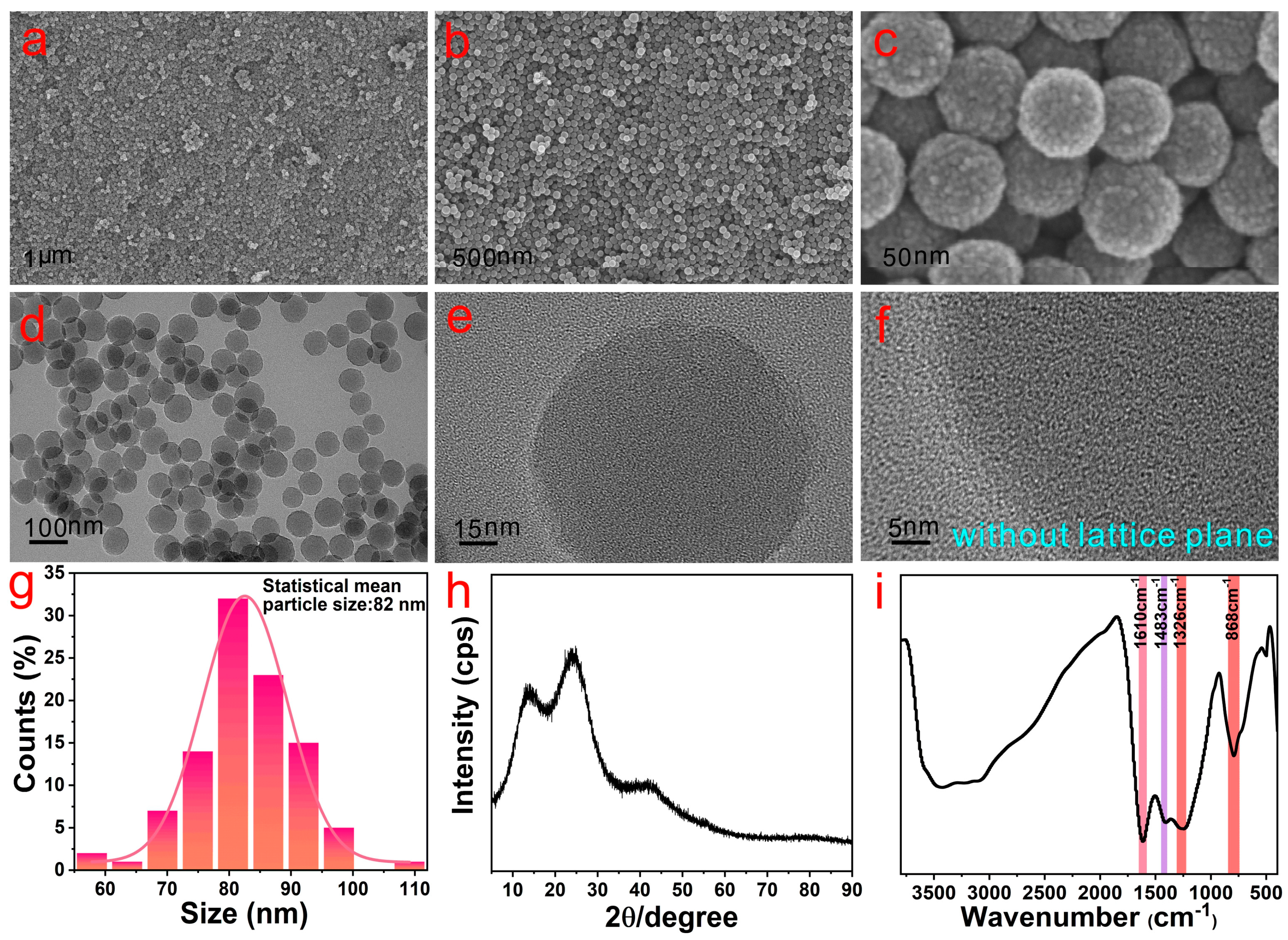
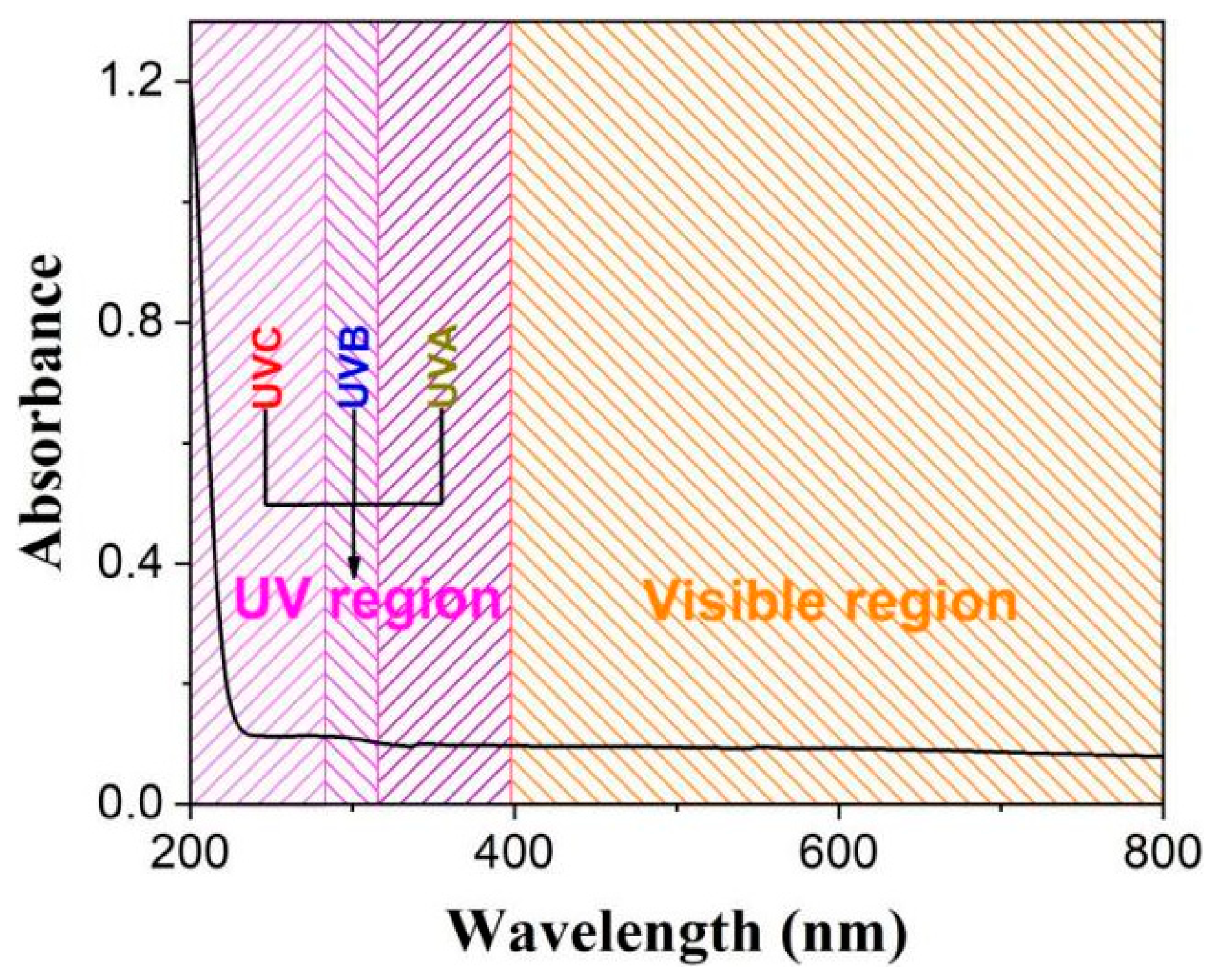
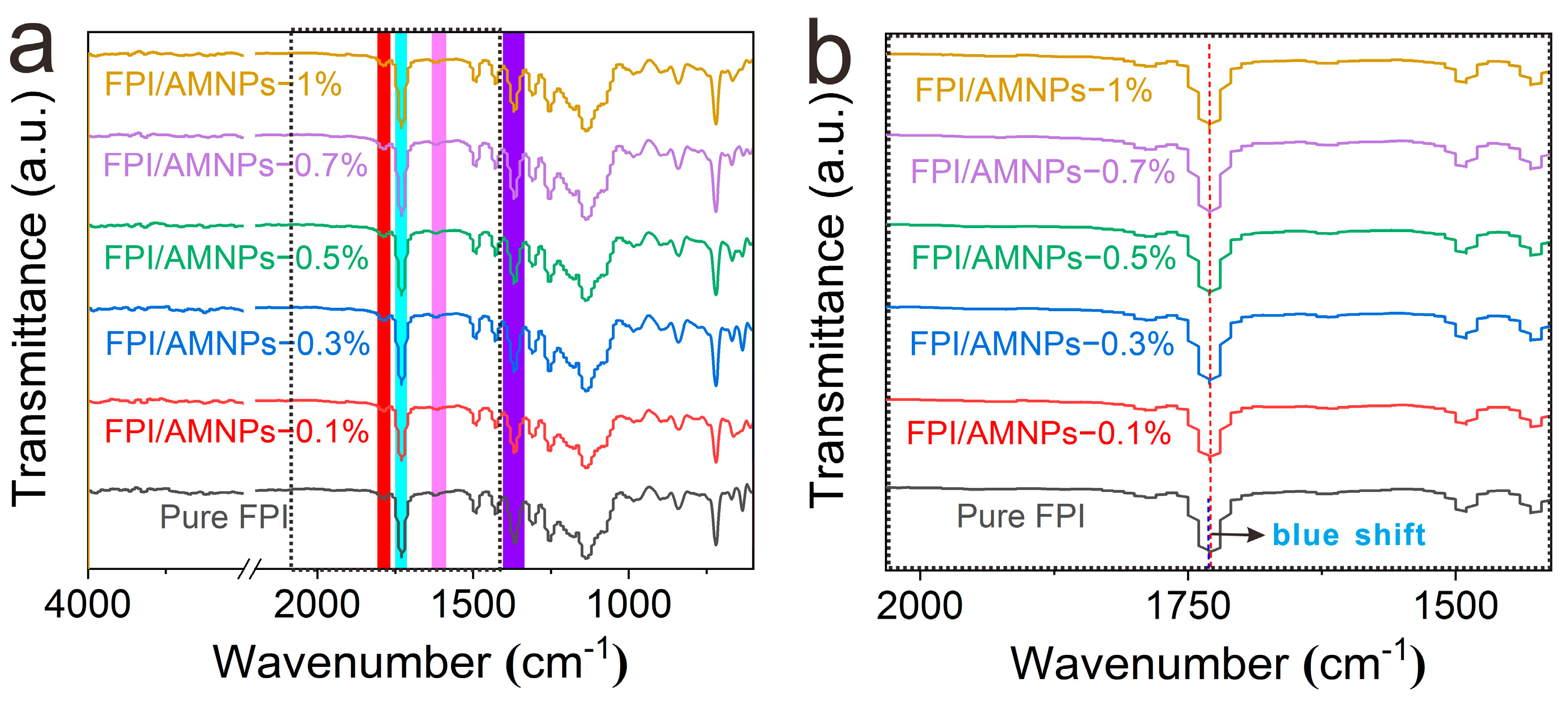
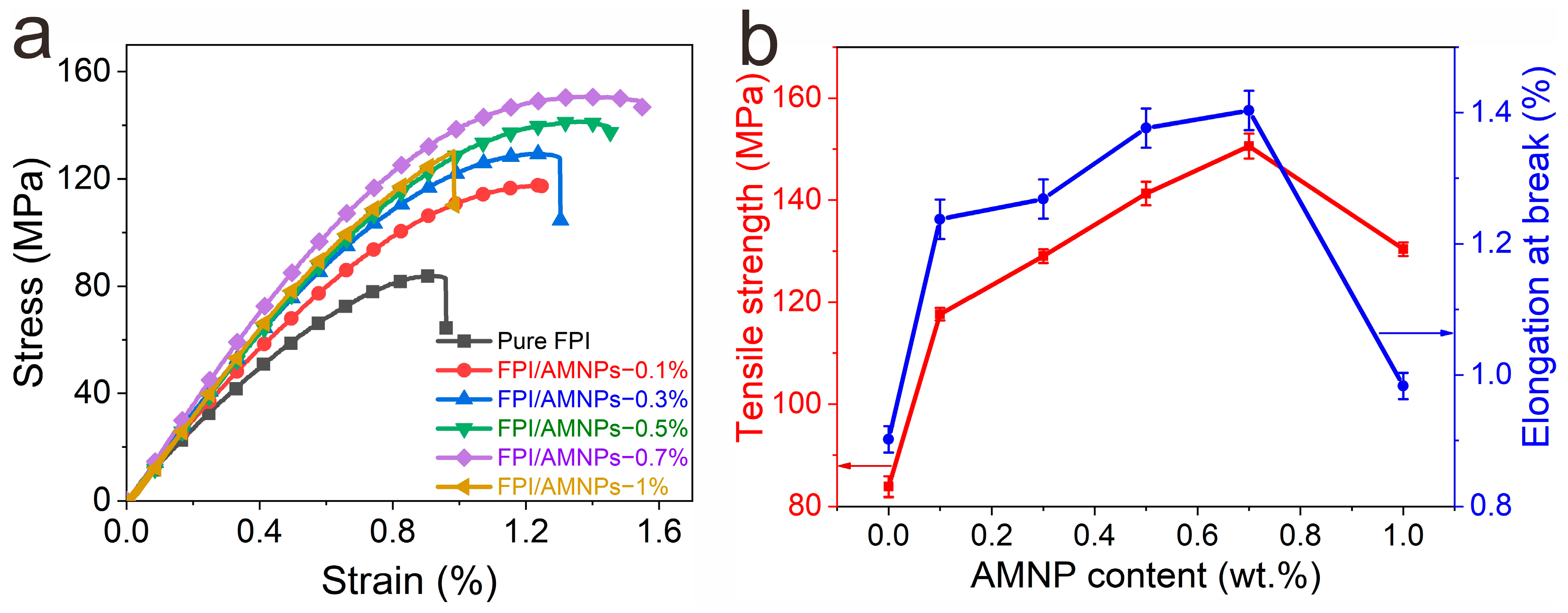

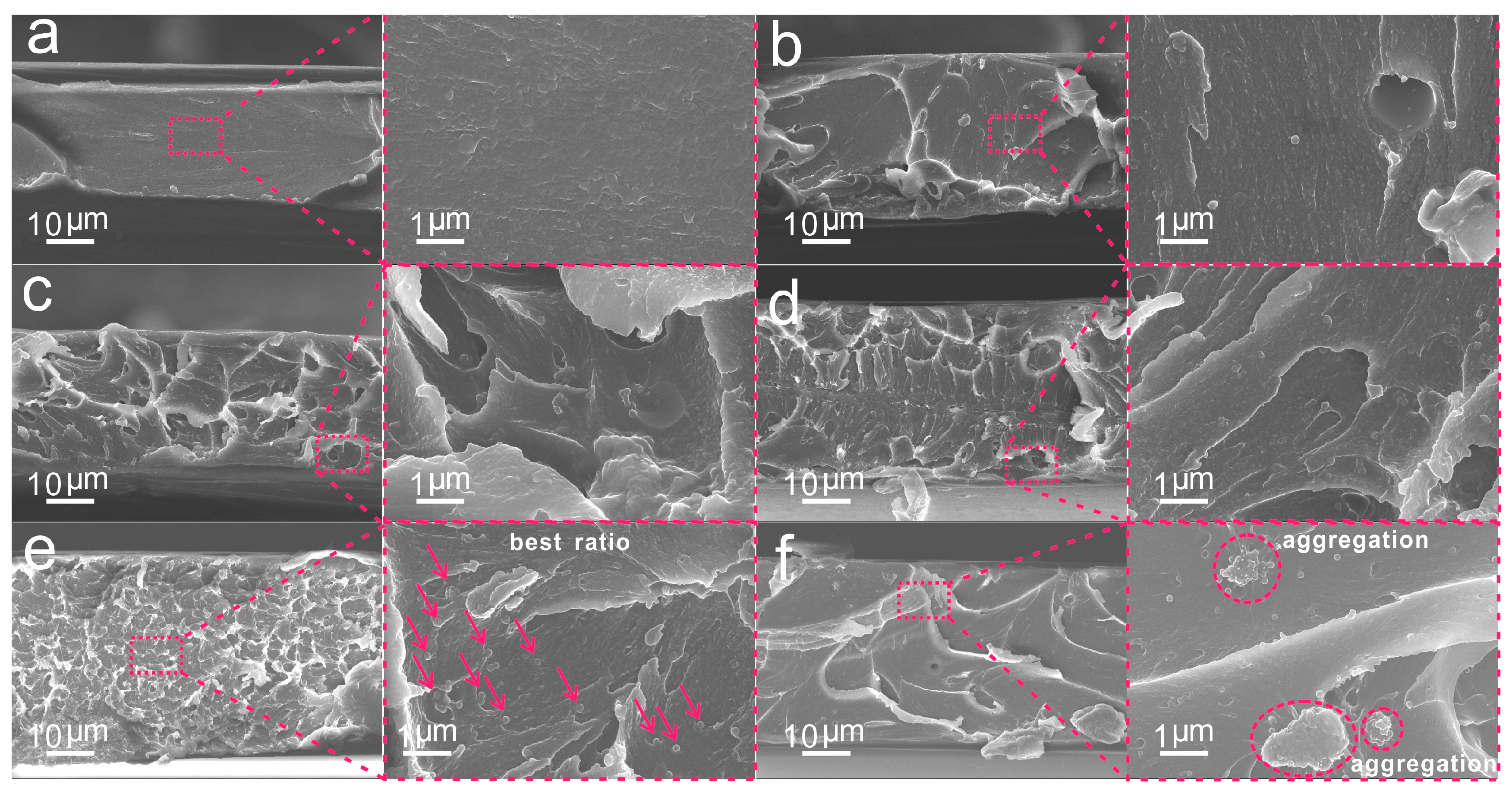
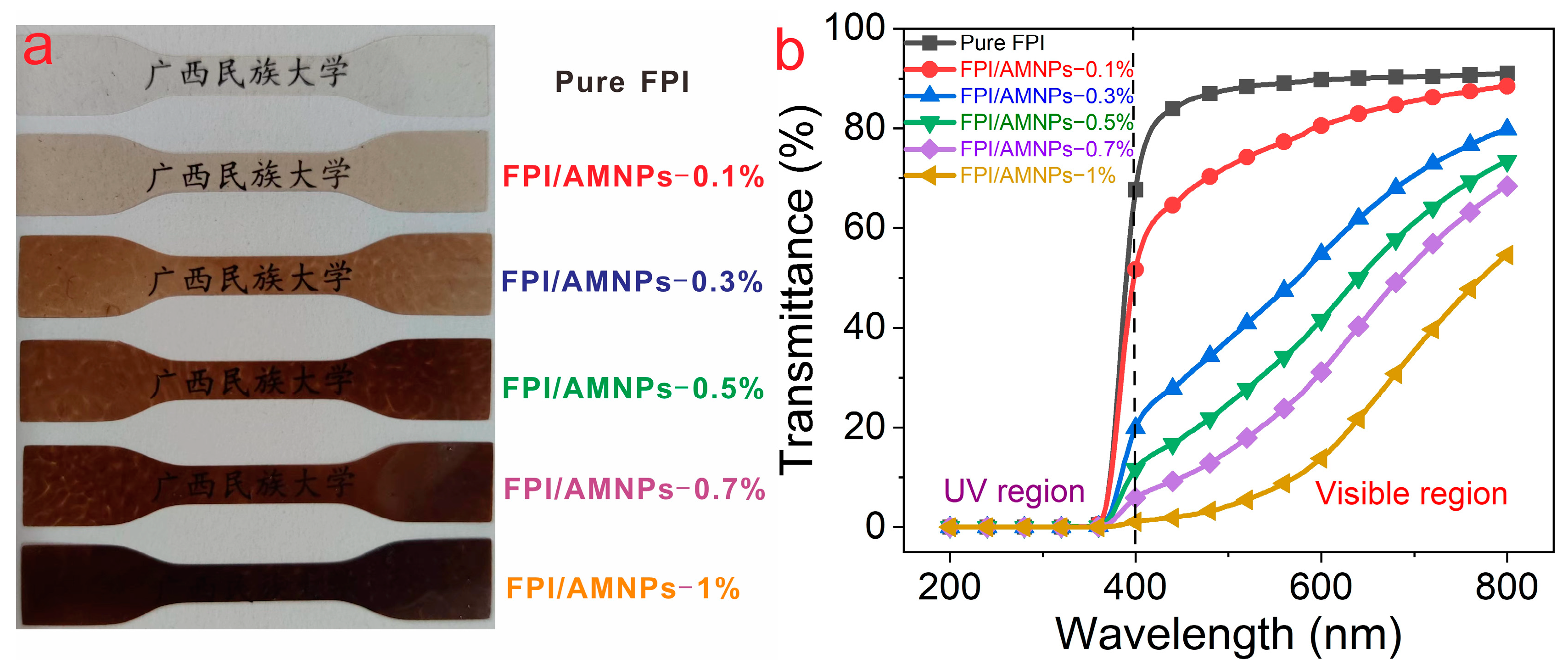
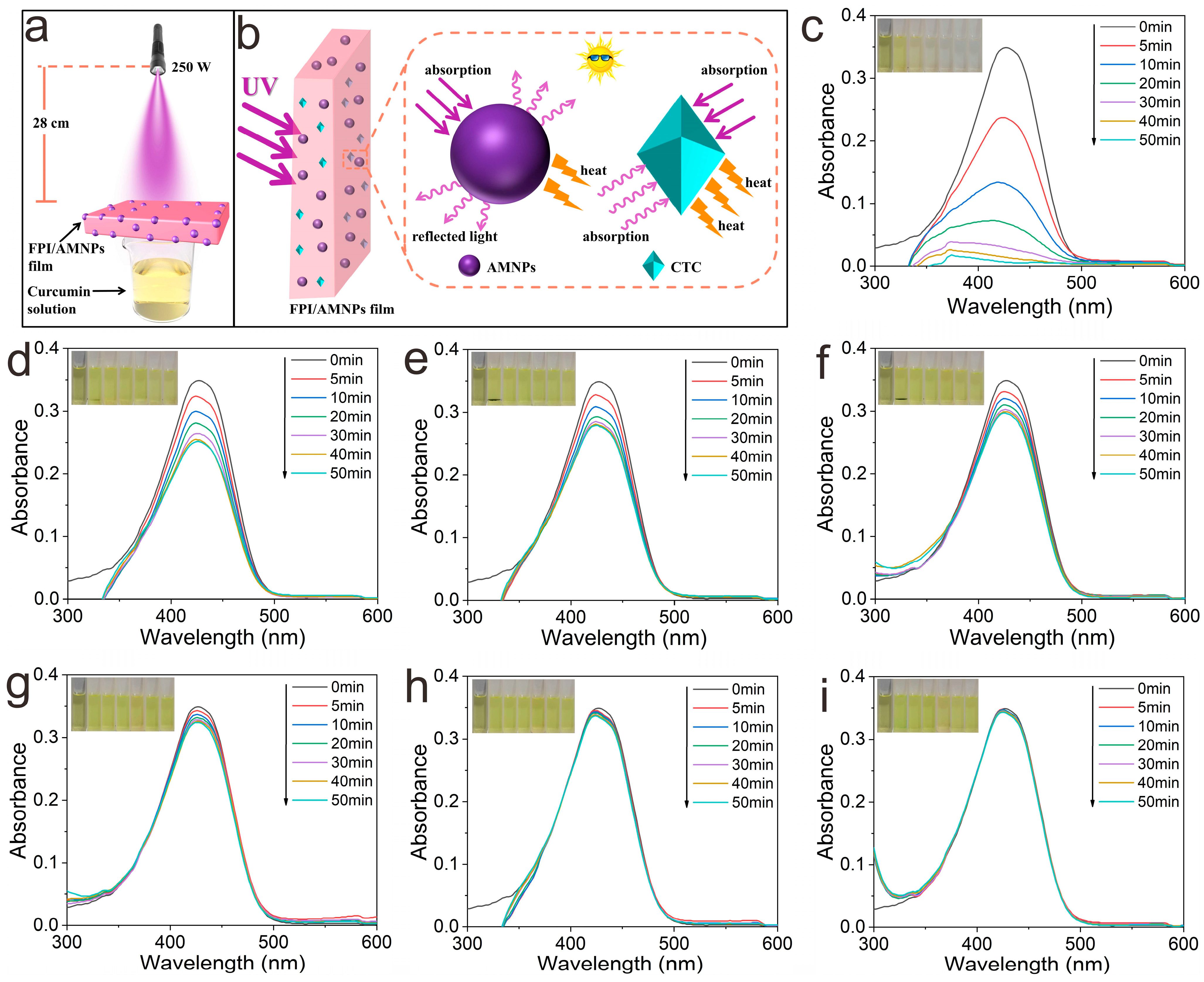

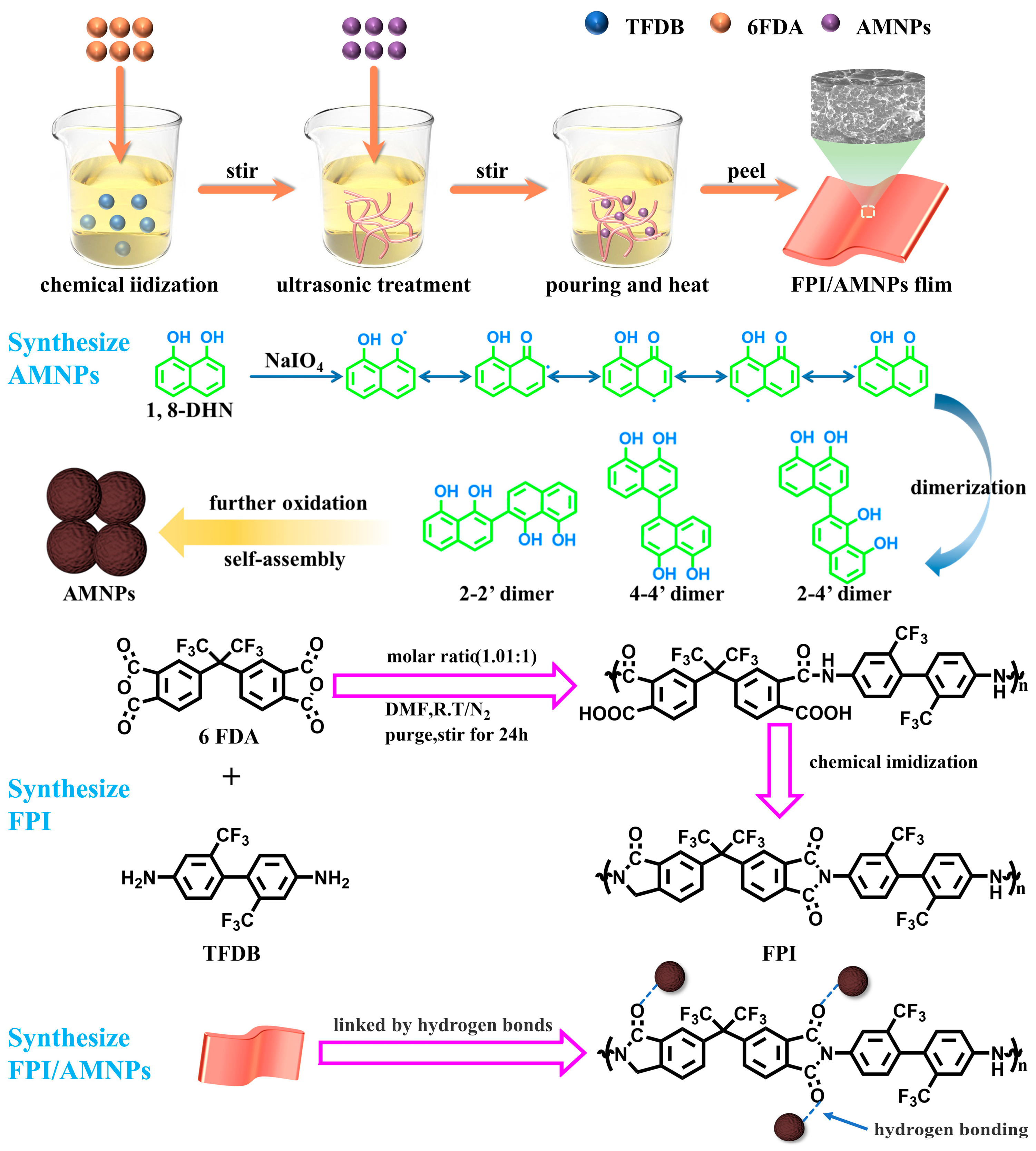
| Sample | AMNPs (wt.%) | Tensile Strength (σ) (MPa) | Elongation at Break (εmax) (%) |
|---|---|---|---|
| FPI/AMNPs-0% | 0 | 83.83 ± 2.01 | 0.90 ± 0.02 |
| FPI/AMNPs-0.1% | 0.1 | 117.61 ± 1.24 | 1.24 ± 0.03 |
| FPI/AMNPs-0.3% | 0.3 | 129.02 ± 1.35 | 1.27 ± 0.03 |
| FPI/AMNPs-0.5% | 0.5 | 141.28 ± 2.31 | 1.38 ± 0.03 |
| FPI/AMNPs-0.7% | 0.7 | 150.59 ± 2.45 | 1.40 ± 0.03 |
| FPI/AMNPs-1% | 1 | 130.38 ± 1.33 | 0.98 ± 0.02 |
Disclaimer/Publisher’s Note: The statements, opinions and data contained in all publications are solely those of the individual author(s) and contributor(s) and not of MDPI and/or the editor(s). MDPI and/or the editor(s) disclaim responsibility for any injury to people or property resulting from any ideas, methods, instructions or products referred to in the content. |
© 2023 by the authors. Licensee MDPI, Basel, Switzerland. This article is an open access article distributed under the terms and conditions of the Creative Commons Attribution (CC BY) license (https://creativecommons.org/licenses/by/4.0/).
Share and Cite
Li, Q.; Guo, Y.; Wu, M.; Deng, F.; Feng, J.; Liu, J.; Liu, S.; Ouyang, C.; Duan, W.; Yi, S.; et al. Fluorinated Polyimide/Allomelanin Nanocomposites for UV-Shielding Applications. Molecules 2023, 28, 5523. https://doi.org/10.3390/molecules28145523
Li Q, Guo Y, Wu M, Deng F, Feng J, Liu J, Liu S, Ouyang C, Duan W, Yi S, et al. Fluorinated Polyimide/Allomelanin Nanocomposites for UV-Shielding Applications. Molecules. 2023; 28(14):5523. https://doi.org/10.3390/molecules28145523
Chicago/Turabian StyleLi, Qing, Yujuan Guo, Meijia Wu, Fei Deng, Jieying Feng, Jiafeng Liu, Sheng Liu, Chaoliu Ouyang, Wengui Duan, Shunmin Yi, and et al. 2023. "Fluorinated Polyimide/Allomelanin Nanocomposites for UV-Shielding Applications" Molecules 28, no. 14: 5523. https://doi.org/10.3390/molecules28145523







